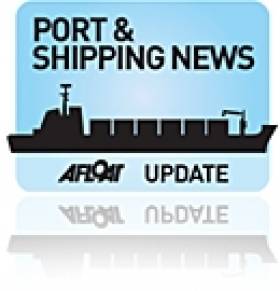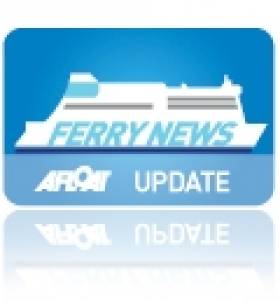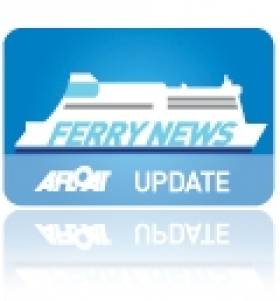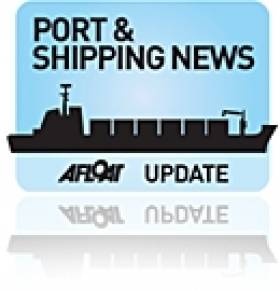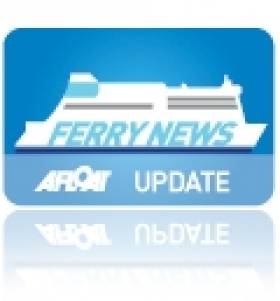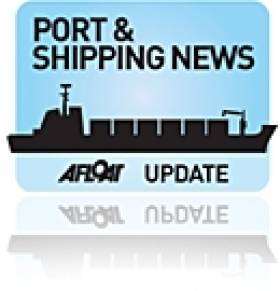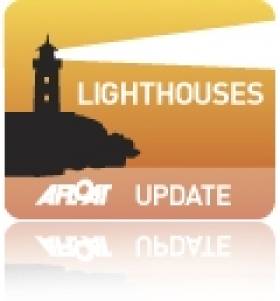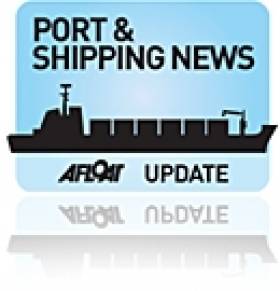Displaying items by tag: Ports and Shipping News
Irish Ports and Shipping Volumes Remain Steady in Third Quarter
#PORT & SHIPPING – According to the Irish Maritime Development Office (IMDO) the volume of port and shipping traffic through the Republic of Ireland remained relatively stable in the third quarter of 2012.
The latest analysis of the traffic data indicates that two of the five principal freight segments returned to growth in the third quarter, two declined and one remained unchanged.
Lift-on/lift-off (Lo/lo) trades declined 2%
Container traffic (Lo/lo) has declined by 2% during the third quarter of this year. Exports, as a subset of these figures fell for the second consecutive quarter, declining by 3% as weaker demand conditions prevailed, particularly in the Euro zone area. However, exports to other markets in Asia, South Africa, and both North and Latin America remained relatively firm. Imports declined by 1%, representing the 19th consecutive quarter of declining import volumes. However, the rate of decline in this segment has eased considerably over the course of 2012, possibly indicating the market might be finally bottoming out.
Roll-on/Roll-off (Ro/ro) traffic was unchanged at 0%
Roll-on/roll-off (ro/ro) traffic remained unchanged in the Republic of Ireland for Quarter 3 compared to the same period last year. The majority of ro/ro freight from Ireland is destined for Great Britain which continues to underperform, with leading economic indicators recording weaknesses in the retail and manufacturing sectors. Nonetheless, this is a slight improvement for this shipping market segment having recorded two consecutive quarterly declines earlier this year.
Dry bulk volumes increased by 13%
Dry bulk shipments, which make up the largest volume of traffic throughput at Irish ports, grew by 13% during the third quarter of 2012. Improved domestic demand for agricultural products contributed to the rise while exports of ores and other industrial commodities also performed well.
Tanker/Liquid bulk market increased by 9%
Liquid bulk volumes of tanker based petroleum products increased by 9% in the third quarter. This increase was primarily as a result of large volumes of crude oil being transhipped at Bantry Harbour's oil storage facilities. Excluding Bantry, volumes would have seen a decline of 8% in Quarter 3, which perhaps more accurately reflects domestic demand for petroleum products.
Break bulk volumes down by 10%
Break bulk volumes, which represent the smallest segment of the domestic market, continued to decline into Quarter 3, falling by 10% with no rise in demand for construction related materials such as steel or timber. Demand in this segment remains at historically low levels.
Outlook: The outlook for the remainder of the year appears to suggest slightly improved conditions in both import and export volumes. This is as a result of a modest pick up in seasonal trade observed during October and early November. Nonetheless, market demand conditions going forward into 2013 remain challenging. The Euro-zone officially entered into its second recession since 2009 during the third quarter this year, while continued uncertainty regarding Greece and some other member states still remains.
Globally, much focus has been on the slowdown in the Chinese and other Asian economies. The Irish growth forecast has also been revised downwards for 2013. Sentiment amongst major shipping lines and shipowners remains low. Many shipowners have to deal with a large over supply of shipping capacity in almost all sectors along with weak underlying trade demand, increased operating costs and record low charter markets.
French Ferry Sailings Set to Resume Service
#FERRY TO RESUME – Services on Celtic Link Ferries Rosslare-Cherbourg route as previously reported on Afloat.ie are scheduled to resume with tomorrow (20 November) night's sailing departing 21.30hrs.
According to the ferry operator, the ro-pax ferry Celtic Horizon will be operating to a reduced capacity, however the sailing will mark the return of standard sailing times.
Due to the restrictions in place any passenger with special needs are requested to contact CLF on 053 916 2688 (Ireland) or 02 33 43 23 87 (France) and for further information visit www.celticlinkferries.com
No Ferry Sailing due to Mooring Issue in Cherbourg
#NO FERRY SAILING – Due to a mooring issue that took place in Cherbourg, there will be no sailing today (18 November) on Celtic Link Ferries 19.00hr departure from Cherbourg to Rosslare.
According to the operator's website, yesterday's outward sailing from Rosslare was also cancelled and that passengers intending to travel today will also be looked after on other sailings. In the meantime the ro-pax vessel remains berthed at Rosslare Europort.
To keep updated of further developments passengers are requested to consult the operators website HERE and by contacting CLF on 053 916 2688 (Ireland) or 02 33 43 23 87 (France).
Stena Line Wins Scottish Passenger Association Award
#FERRY AWARD – Stena Line's first anniversary of the Belfast-Cairnryan route was celebrated with an award for Best Ferry Operator, reports Carrick Today.
The Scottish service is one of five routes the ferry operator runs on the Irish Sea and in which the annual travel excellence award was presented at the Scottish Passenger Agents' Association (SPAA) awards.
Diane Poole OBE, Stena Line's Head of PR and Communications, said she was delighted to see the company receive the title. "It is always a great honour to receive an award but this one is special as it is recognition from our peers in the travel world," she said. "Stena Line would like to thank all at SPAA for their continued work to promote all that is great about our travel industry."
Patrol Ship Purchased, Dublin Dry-Dockings, Belfast Port Masterplan, IMDO Launch Report, Naval and Cruiseship News
#PORTS & SHIPPING REVIEW - Over the last fortnight Jehan Ashmore has reported from the shipping scene where the Royal Navy's fishery patrol vessel HMS Mersey docked in Dublin Port, having been purchased from her shipbuilder-owners as part of a £39m deal.
One of the largest vessels of the Arklow Shipping Ltd fleet, Arklow Manor of 9,682grt/14,008dwt arrived in Dublin Port to enter the dry-dock facility, one of her sisters had also used the dry-dock in Alexandra Basin earlier this year.
P&O Cruises Adonia, became the final cruise caller to Dublin Port this year, having spent a day at sea after departing Cobh Cruise Terminal the previous day. She led the fleet during the 175th anniversary 'Grand Event' which formed one of the lectures during last month's London Ship Show.
A Masterplan setting out the future for the next 20-30 years for Belfast Harbour was launched, those interested in making comments on the plans are asked to respond by 7 December.
The Irish Maritime Development Office (IMDO) released a report of the nine semi-state port's financial statements for the year end 2011. A key finding is that after a combined growth of 3% in turnover in 2010, the ports recorded a fall in turnover of 3% in 2011 with turnover falling to €120m.
Naval Service OPV L.E. Emer (P21) detained an Irish fishing vessel off the south-east coast over alleged breaches of fishing regulations and was escorted to Cork and handed over to the Gardai.
In 2013 Cruise & Maritime Voyages are to charter Discovery (1971/20,216grt) for the UK cruising season. She is scheduled to make her debut 'Irish' port of call to Dublin Port in April, which will also mark the start of the cruise season to the capital.
End of Season Sailing for Brittany Ferries
#FERRY NEWS- The final Brittany Ferries sailing for 2012 departs on the return leg of the Cork-Roscoff route next Saturday 3 November, writes Jehan Ashmore.
Those intending to book on the 14-hour route, only operated on weekends, should consult the ferry company's website for sailing times and prices.
Brittany Ferries have operated the route to France since 1978, first served by the Armorique. Currently the service is served by flagship Pont-Aven. The German built cruiseferry also maintains crossings on a triangular route network between France and the UK and also UK-Spain.
Next year's season opens with a sailing departing Roscoff on 22 March 2013 and with a return sailing to the Breton port from Cork's Ringaskiddy ferry terminal on 23 March.
A Year on the Horizon for Celtic Link's Ro-Pax Ferry
#CELTIC LINK - The Celtic Horizon, the 27,522 tonnes ro-pax ferry this week celebrates her first year in service on Celtic Link Ferries Rosslare-Cherbourg route, writes Jehan Ashmore.
According to the Celtic Link they have had a 'resoundingly successful inaugural year with the Celtic Horizon'. The Co. Wexford based operator saw double digit-growth in the number of tourist passengers sailing on the 17 hour route.
Celtic Link envisage that this growth will continue in 2013 and as the only year-round operator between Ireland and France. On the freight front, strong performance has been recorded despite the turbulent economic conditions in which the company has claimed to have performed in line with yearly forecasts.
The 1000 passenger capacity ferry, with space for 200 cars and up to 120 freight vehicles, completed her first round trip voyage last October, having been chartered by CLF for a five-year term contract. On board the 186m vessel facilities include 110 cabins, a bar, restaurant, lounges, cinema, shop and wi-fi connectivity.
Celtic Horizon was built in 2006 by Cantiere Navala Visentini, Portoviro, in Italy and she retains her port registry of Bari. As the Cartour Beta, she began her career serving routes between Naples and Sicily for Caronte & Tourist (C&T) until her charter ceased late last summer.
Last September, the vessel was berthed in Palermo, in advance of her four-day delivery voyage to Ireland. The voyage set a course that saw her offshore of the Algerian coast and before leaving the Mediterranean, an en-route call was made to Gibraltar to load bunkers, until she finally reached Rosslare Harbour.
She has more passenger deck space compared to her predecessor, Norman Voyager, which likewise was built of the same overall ro-pax design of the Italian shipbuilder. A notable and novel feature is the escalator which whisks passengers from the vehicle decks to the main passenger deck.
Ports & Shipping Review: Cruising to the Sun, WWI Warship’s Tourist Role, Stena’s 50th Year, Cargoship Record, Dock Survey of Lighthouse tender and more…
#PORTS & SHIPPING REVIEW - Over the last fortnight Jehan Ashmore has reported from the shipping scene where Irish passengers left wintery conditions by embarking on a cruise directly from Dublin Port which was bound for sunnier climes in Iberia and the Atlantic isles.
A multi-cat workboat, Island Kestral was acquired by Wicklow based Island Shipping, the vessel will be chartered to offshore projects including the renewables industry sector.
Following the fate of the WW1 Battle of Jutland cruiser HMS Caroline, which is to remain in Belfast, the 98-year vessel is to be made into a tourist visitor attraction, likewise of London's HMS Belfast, another veteran but from WW2.
Those considering a career at sea, should take note that the National Maritime College of Ireland (NMCI) is to host a 'Open' Day next Tuesday (23 October) at the campus based in Ringaskiddy.
What's in a name...Stena Line, a household name, but did you realise that the Swedish owned ferry giant derives its name from founder Sten A. Ollsen, and this year celebrates its 50th anniversary. How did the company become to where it is today, operating 19 routes which includes Dun Laoghaire-Holyhead, served by the HSS Stena Explorer, which is to return to the route for 12 days during the festive and new year periods.
While Irish Sea rivals, Irish Ferries is to add a third ferry on to the Dublin Port-Holyhead route also to cover for the festive and new year sailings. The unprecedented transfer of the Isle of Inishmore will join the route's existing tonnage, Ulysses and fast-ferry Jonathan Swift, to provide additional capacity during the busy season.
Those with a strong interest in liners, should head for the London Ship Show next Saturday (27 October). Among the exhibitors are maritime booksellers, artists, model-makers, traders in memorabilia and ephemera postcards. There will be talks about P&O Cruises 175th anniversary 'Grand Event' in the Solent which featured the Arcadia that sailed to Dublin.
A major international conference on Ocean Energy was held in Dublin's Convention Centre and facing opposite the venue, a scientific weather buoy was positioned on the Liffey.
Passengers travelling on ferry routes will be able to have the same travel rights given to those flying or taking the train, when the National Roads Authority is to implement on 18 December.
A record breaking single cargo shipment of 56,000 tonnes of coal, was set in Belfast Harbour, when the bulk-carrier Ocean Breeze docked in the port having sailed from Virginia in the U.S.
Irish Rail which operates Rosslare Europort is to undergo a strategic review, which is predominantly served by the ferry sector, could be transferred to potentially different ownership.
Today the tallship Tenacious is having an 'Open' Day, where the public can board the 65m barque berthed at Sir John Rogersons Quay in Dublins Docklands between 10.00am-12.30pm and 2-4pm.
The hard-working lighthouse tender ILV Granuaile is undergoing a docking survey in Cork Dockyard. The vessel was built in Galati on the River Danube, Romania for the Commissioners of Irish Lights whose headquarters are in Dun Laoghaire, which is the vessel's homeport.
Cork Dockyard Carries Out Docking Survey of Lighthouse Tender
#DOCKING SURVEY– The Commissioners of Irish Lights aids to navigation tender ILV Granuaile (2000/2,625grt) is currently at Cork Dockyard Ltd undergoing her scheduled docking survey, writes Jehan Ashmore.
The tender built in Romania over a decade ago and fitted out in the Netherlands by the Damen Shipyard Group, is required under regulation to drydock twice in five-yearly cycles. Her last docking was in 2009 and the the bouy-laying vessel is due her next scheduled docking in 2014.
Such docking is required by Classification Societies to inspect the underwater areas including hull, propellers, rudders, engine cooling systems, anchors, cables and anti corrosion systems.
At the same time the opportunity is taken to remove marine growth and to apply antifouling paint coatings to the underwater areas and to prepare and paint the ships hull. The principle dimensions of the hull are 79m long on a beam of 15m and with a shallow draft of 4.4m.
She has accommodation for an extra 10 persons or can accept modular housing on the after-deck where navigational aids (bouys) are stowed in cradles. Heavy lifting equipment including a 20 tonne crane with an outreach of 20m is used to position the bouys at pinpoint accuracy using satellite technology. There are 150 offshore buoys which warn mariners of the location of sand banks, reefs, and other offshore hazards near shipping routes.
A helicopter landing deck over the bow is used to transfer maintenance personnel and equipment to certain lighthouses.
ILV Granuaile's homeport is Dun Loaghaire Harbour, where she is seen frequently loading and unloading buoys alongside the various piers. On occasions she enters through the marina to berth alongside the Commissioners headquarters which includes a marine workshop depot facility, though this can only be done on certain tides and for a short duration.
Asides her primary duties serving the lighthouse authority, the vessel is capable of carrying out chain work, search and rescue, salvage and recovery, oil pollution control, towing, hydrographic applications, and ROV work.
Review of Rosslare Could Lead to Change of Ownership
#ROSSLARE - The Department of Transport has tendered for external consultants to carry out a strategic review of Rosslare Europort, the Co. Wexford harbour which is predominantly a ferryport is currently operated by Irish Rail, the Irish Times reports.
The advisers will be asked to review the port's current commercial and operational efficiency and advise on an appropriate ownership structure.
This could include local authority involvement or some form of privatisation. It is understood the Government would prefer to retain Rosslare in state ownership, given its importance to tourism and trade.


























